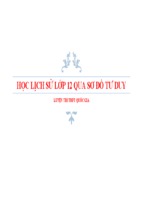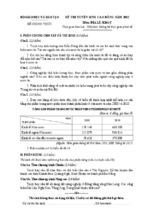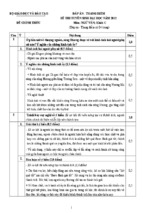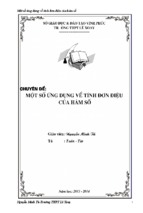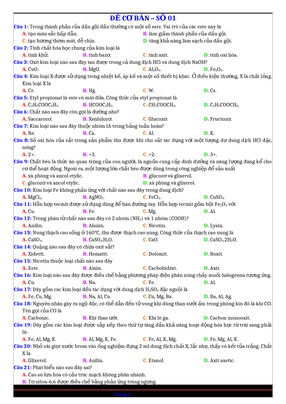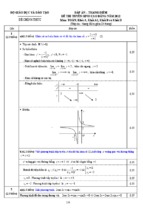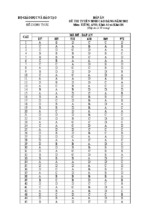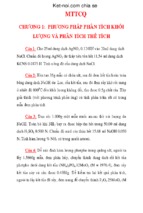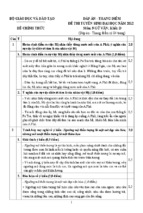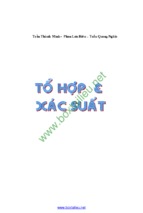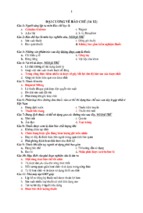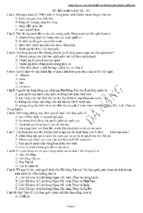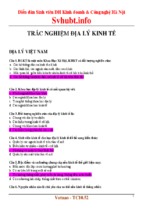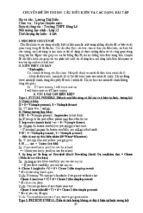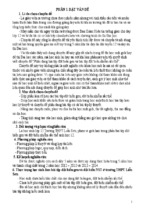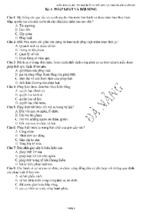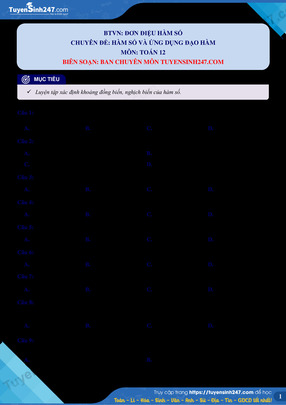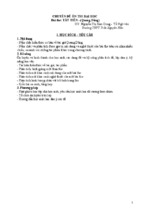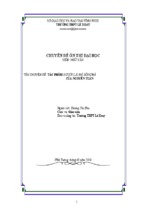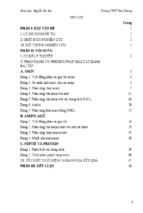T SÁCH LUY N THI
50 Đ THI TH THPT QU C GIA 2020
MÔN TI NG ANH
CÓ ĐÁP ÁN VÀ GI I CHI TI T
ĐỀ THI THỬ THPT QUỐC GIA 2020
MÔN TIẾNG ANH
Thời gian: 60 phút
ĐỀ 1
Mark the letter A, B, C, D on your answer sheet to indicate the word whose underlined part
differs from the other three in each of the following question.
Question 1. A. cried
B. published
C. ordered
D. sprayed
Question 2. A. houses
B. services
C. passages
D. techniques
Mark the letter A, B, C, D on your answer sheet to indicate the word that differs from the
other three in the position of primary stress in each of the following question.
Question 3. A. private
B. provide
C. arrange
D. advise
Question 4. A. particular
B. significant
C. satisfaction
D. collaborate
Mark the letter A, B, C, D on your answer sheet to indicate the correct answer to each of the
following questions.
piano since she was 10 years of age.
Question 5. She has been playing
A. a
B. an
C. the
D. X (no article)
Question 6. You
many good choices for the future if you are admitted to a famous
university.
A. will have
B. had
C. would have
D. would have had
Question 7. Bruce was not promoted to a higher position________he was a devoted worker.
A. despite
B. in spite of
C. although
D. no matter how
Question 8. The teacher criticized me________making too many stupid mistakes in the essay.
A. on
B. for
C. about
D. by
Question 9. ________the destination, everyone felt a relief.
A. Reached
B. When reached
C. On reaching
D. Having been reached
Question 10. We noticed a very sneaky man while we_________at the checkout.
A. stood
B. are standing
C. had stood
D. were standing
Question 11. __________a good chance, don’t let it slip away!
A. If given
B. You are given
Question 12. The stockbroker denied
A. having informed
C. having been informed
C. If you give
D. Being given
of the secret business deal.
B. to have been informed
D. to have informed
Mark the letter A, B, C, or D on your answer sheet to indicate the word that is CLOSEST
in meaning to the underlined part in each of the following questions.
Question 13. The helicopter carrier is indispensable in marine operations against sea or
enemies.
Trang 1
Trang 1
A. unique
B. novel
C. exotic
D. vital
Question 14. Researchers warn of the impending extinction of many species of plants and
animals.
A. inevitable
B. imminent
C. formidable
D. absolute
Mark the letter A, B, C, or D on your answer sheet to indicate the word that is
OPPOSITE in meaning to the underlined part in each of the following questions.
Question 15. It was a heartfelt confession.
A. loving
B. insincere
C. unhealthy
D. humorous
Question 16. Is he looking for a temporary or a permanent contract?
A. fleeting
B. fierce
C. stable
D. loose
Mark the letter A, B, C, or D on your answer sheet to show the underlined part that needs
correction
Question 17.
It is time the management do something to support the unemployed to find some jobs.
A
B
C
D
Question 18. I enjoy reading the editorial that you told me about it yesterday.
A
B
C
D
Question 19. Students suppose to read all the problems carefully and find out
A
B
C
the solution to them.
D
Read the following passage and mark the letter A, B, C or D on your answer sheet to
indicate the correct answer to each of the following questions from 20 to 24.
In the world today, particularly in the two most industrialized areas, North America and
Europe, recycling is big news. People are talking about it, practicing it, and discovering new
ways to be sensitive to the environment. Recycling means finding was to use products a second
time. The motto of the recycling movement is "Reduce, Reuse, Recycle".
The first step is to reduce garbage. In stores, a shopper has to buy products in blister
packs, boxes and expensive plastic wrappings. A hamburger from a fast food restaurant comes
in lots of packaging: usually paper, a box, and a bag. All that packaging is wasted resources.
People should try to buy things that are wrapped simply, and to reuse cups and utensils.
Another way to reduce waste is to buy high- quality products. When low quality appliances
break, many customers throw them away and buy new ones - a loss of more resources and
more energy. For example, if a customer buys a high-quality appliance that can be easily
repaired, the manufacturer receives an important message. In the same way, if a customer
chooses a product with less packaging, that customer sends an important message to the
manufacturers. To reduce garbage, the throwaway must stop.
Trang 2
Trang 2
The second step is to reuse. It is better to buy juices and soft drinks in returnable bottles.
After customers empty the bottles, they return them to the store. The manufacturers of the
drinks collect the bottles, wash them, and then fill them again. The energy that is necessary to
make new bottles is saved. In some parts of the world, returning bottles for money is a
common practice. In those places, the garbage dumps have relatively little glass and plastic
from throwaway bottles.
The third step is being environmentally sensitive is to recycle. Spent motor oil can be
cleaned and used again. Aluminum cans are expensive to make. It takes the same amount of
energy to make one aluminum can as it does to run a color TV set for three hours. When people
collect and recycle aluminum (for new cans), they help save one of the world's precious
resources.
(Source: https://hbr.org/1993/11)
Question 20. What is the main topic of the passage?
A. How to reduce garbage disposal
B. What people often understand about the term “recycle”
C. What is involved in the recycling movement
D. How to live sensitively to the environment
Question 21. People can do the following to reduce waste EXCEPT:
B. buy simply-wrapped things
A. buy high-quality product
C. reuse cups
D. buy fewer hamburgers
Question 22. Why is it a waste when customers buy low-quality products?
A. Because people will soon throw them away.
B. Because they have to be repaired many times.
C. Because customers change their ideas all the time.
D. Because they produce less energy.
Question 23. What best describes the process of reuse?
A. The bottles are collected, washed, returned and filled again.
B. The bottles are filled again after being returned, collected and washed.
C. The bottles are washed, retuned, filled again and collected.
D. The bottles are collected, returned filled again and washed.
Question 24 What are the two things mentioned as examples of recycling?
A. Aluminum cans and plastic wrappings.
B. Hamburger wrappings and spent motor oil.
C. Aluminum cans and spent motor oil.
D. TV sets and aluminum cans.
Read the following passage and mark the letter A, B, C, or D to indicate the best
option for each of the blanks from 25 to 29.
From the seeds themselves to the machinery, fertilizers and pesticides - The Green
Revolution regimen depend heavily on technology. One...........(25)........ however, depends
much more on technology - organic farming. Many organic farmers use machinery,
but...........(26)..........chemical fertilizers or pesticides. ..........(27)..........chemical soil enrichers,
they use animal manure and plant parts not used as food - natural, organic fertilizers that are
Trang 3
Trang 3
clearly a renewable........(28)........ Organic farmers also use alternatives for pesticides; for
example, they may rely........(29)..........natural predators of certain insect pests. Then, the need
arises, they can buy the eggs and larvae of these natural predators and introduce them into their
crop fields.
(Source: https://horticultureandsoilscience.fandom.com/)
Question 25. A. alternative
Question 26. A. also
Question 27. A. In spite of
Question 28. A. resource
Question 29. A. of
B. alternate
B. for
B. On account of
B. source
B. to
C. alteration
C. not
C. In favour of
C. matter
C. on
D.alternation
D. all
D. Instead of
D. substance
D. in
Read the following passage and mark the letter A, B, C or D on your answer sheet
to indicate the correct answer to each of the following questions from 30 to 37.
An air pollutant is defined as a compound added directly or indirectly by humans to the
atmosphere in such quantities as to affect humans, animals, vegetation, or materials adversely.
Air pollution requires a very flexible definition that permits continuous change. When the first
air pollution laws were established in England in the fourteenth century, air pollutants were
limited to compounds that could be seen or smelled - a far cry from the extensive list of
harmful substances known today. As technology has developed and knowledge of the health
aspects of various chemicals has increased, the list of air pollutants has lengthened. In the
future, even water vapor might be considered an air pollutant under certain conditions.
Many of the more important air pollutants, such as sulfur oxides, carbon monoxide, and
nitrogen oxides, are found in nature. As the Earth developed, the concentration of these
pollutants was altered by various chemical reactions; they became components in
biogeochemical cycles. These serve as an air purification scheme by allowing the compounds
to move from the air to the water or soil. On a global basis, nature's output of these compounds
dwarfs that resulting from human activities.
However, human production usually occurs in a localized area, such as a city. In such a
region, human output may be dominant and may temporarily overload the natural purification
scheme of the cycles. The result is an increased concentration of noxious chemicals in the air.
The concentrations at which the adverse effects appear will be greater than the concentrations
that the pollutants would have in the absence of human activities. The actual concentration
need not be large for a substance to be a pollutant; in fact, the numerical value tells us little
until we know how much of an increase this represents over the concentration that would occur
naturally in the area. For example, sulfur dioxide has detectable health effects at 0.08 parts per
million (ppm), which is about 400 times its natural level. Carbon monoxide, however, has a
natural level of 0.1 ppm and is not usually a pollutant until its level reaches about 15 ppm.
(source: http://www.ilocis.org)
Question 30. What does the passage mainly discuss?
A. The economic impact of air pollution.
B. What constitutes an air pollutant.
C. How much harm air pollutants can cause.
D. The effects of compounds added to the atmosphere.
Trang 4
Trang 4
Question 31. It can be inferred from the first paragraph that ___________.
A. water vapor is an air pollutant in localized areas
B. most air pollutants today can be seen or smelled
C. the definition of air pollution will continue to change
D. a substance becomes an air pollutant only in cities
Question 32. For which of the following reasons can natural pollutants play an
important role in controlling air pollution?
A. They function as part of a purification process.
B. They occur in greater quantities than other pollutants.
C. They are less harmful to living beings than other pollutants.
D. They have existed since the Earth developed.
Question 33. According to the passage, human-generated air pollution in localized
regions___________.
A. can be dwarfed by nature's output of pollutants
B. can overwhelm the natural system that removes pollutants
C. will damage areas outside of the localized regions
D. will react harmfully with natural pollutants
Question 34. The word “localized” in the third paragraph is closest in meaning to________.
A. specified
B. circled
C. surrounded
D. encircled
Question 35. According to the passage, the numerical value of the
concentration level of a substance is only useful if ________.
A. the other substances in the area are known
B. it is in a localized area
D. it can be calculated quickly
C. the natural level is also known
Question 36. The word “detectable” in the third paragraph is closest in meaning to____.
A. discernible
B. gradual
C. unobservable
D. impossible
Question 37. Which of the following is best supported by the passage?
A. To effectively control pollution, local government should regularly review their air
pollution laws.
B. One of the most important steps in preserving natural lands is to better enforce air
pollution laws.
C. Scientists should be consulted in order to establish uniform limits for all air pollutants.
D. Human activities have been effective in reducing air pollution.
Mark the letter A, B, C, or D on your answer sheet to indicate the correct answer to each
of the following questions.
Trang 5
Trang 5
Question 38. A trust worker was discovered to have
confidential information to a
rival corporation.
A. stolen
B. spread
C. rumored
D. leaked
Question 39. Poor supervision brought the firm to
of collapse.
A. the edge
B. the foot
C. the ring
D. the brink
Question 40. It never
his mind that his badly behaved manner would be discovered.
A. crossed
B. came
C. spunk
D. passed
Question 41. Tim finds mending old clothes incredibly
, that's why he always asks his
mother to do it for him.
A. hilarious
B. tedious
C. funny
D. recreational
Question 42. As Tim was
of the modification in the schedule, he arrived an hour late
for the meeting.
A. unaware
B. unconscious
C. unable
D. unreasonable
Question 43. Despite a lot of difficulties, the Star City Project will go
.
A. backward
B. forward
C. advance
D. ahead
Mark the letter A, B, C, or D on your answer sheet to indicate the most suitable response
to complete each of the following exchanges.
Question 44. – “Thanks for the lovely party.” – “ ___________.”
A. Yes, it's really great
B. No, it's not good
C. Oh, that's right
D. I'm glad you enjoyed it
Question 45. – “What do you usually do at weekend?” – “ _________.”
A. I usually drive to work
B. I will sleep all day.
C. I usually do not much
D. Nothing much. I always sleep until noon
Mark the letter A, B, C, or D on your answer sheet to indicate the sentence that best
combines each pair of sentences in the following questions.
Question 46. I had never met Rose before. However, I recognized her from a picture.
A. Although I had never met Rose before, I recognized her from a picture.
B. I recognized her from a picture before I had never met Rose.
C. Although I had never met Rose before but I recognized her from a picture.
D. After I had met Rose, I recognized her from a picture.
Question 47. The human brain is 8 times the size of a monkey’s. It weighs about 1,400 grams.
A. The size of human brain is 8 times that of a monkey’s which is about 1,400 grams weigh.
B. The human brain, which weighs about 1,400 grams, is 8 times the size of a monkey’s.
C. The size of a monkey’s brain is 1,400 grams, 8 times that of the human one.
D. The weight of a monkey’s brain is 1,400 grams, 8-fold than that of the human one.
Mark the letter A, B, C, or D on your answer sheet to indicate the sentence that is
closest in meaning to each of the following questions.
Question 48. Tom has the ability to be a professional musician, but he’s too lazy to practice.
A. Tom is talented but he’ll never be a professional musician as he doesn’t practice.
B. As a professional musician Tom is not lazy to practice music lessons.
C. Tom is able to practice music lessons professionally though he is lazy.
D. Though practicing lazily, Tom is a professional musician.
Question 49. Tim broke his arm and couldn’t battle in the final.
A. Tim couldn’t battle in the final due to his broken arm.
B. If Tim hadn’t broken his arm, he could battle in the final now
Trang 6
Trang 6
C. If Tim didn’t break his arm, he could battle in the final.
D. But for his broken arm, Tim couldn’t have played in the final.
Question 50. The teacher couldn’t stand my brother’s manner
A. The teacher found my brother’s manner. intolerant
B. The teacher found my brother’s manner intolerable
C. The teacher was tolerant towards my brother’s manner
D. My brother’s behavior was not manner
-------------The end------------ĐÁP ÁN - HƯỚNG DẪN GIẢI CHI TIẾT ĐỀ THI THỬ THPTQG
Question 1
B Question 11 A Question 21 D Question 31 C Question 41
Question 2
D Question 12 C Question 22 A Question 32 A Question 42
Question 3
A Question 13 D Question 23 B Question 33 B Question 43
Question 4
C Question 14 B Question 24 C Question 34 A Question 44
Question 5
C Question 15 B Question 25 A Question 35 C Question 45
Question 6
A Question 16 A Question 26 A Question 36 A Question 46
Question 7
C Question 17 B Question 27 D Question 37 D Question 47
Question 8
B Question 18 D Question 28 A Question 38 D Question 48
Question 9
C Question 19 A Question 29 C Question 39 D Question 49
Question 10 D Question 20 C Question 30 B Question 40 A Question 50
B
A
D
D
D
A
B
A
A
B
Question 1:
Đáp án : B
Kiến thức: Phát âm “-ed”
Giải thích:
Đuôi “ed” được phát âm là /ɪd/ khi âm tận cùng trước nó là /t/, /d/
Đuôi “ed” được phát âm là /t/ khi âm tận cùng trước nó là /s/, /p/, /f/, / ʃ/, /tʃ/, /k/
Đuôi “ed” được phát âm là /d/ khi âm tận cùng trước nó là các âm còn lại.
- cried /krai/
- published /ˈpʌb.lɪʃ/
- ordered
/ˈɔː.dər/
- sprayed
/spreɪ/
Phần được gạch chân ở câu B được phát âm là /t/, còn lại là /d/.
Question 2.
Đáp án: D
Kiến thức: Phát âm “-s”/ “-es”
Giải thích:
“s” và “es” được phát âm là /ɪz/ khi tận cùng trước nó là /s/, /z/, / ʃ/, /tʃ/, /dz/
“s” sẽ được phát âm là /s/ khi tận cùng trước nó là /p/, /k/, /f/, /t/, /θ/
“s” sẽ được phát âm là /z/ khi tận cùng trước nó là các âm còn lại.
houses /haʊs/
services /ˈsɜː.vɪs/
passages /ˈpæs.ɪdʒ/
techniques /tekˈniːk/
Phần được gạch chân ở câu D được phát âm là /s/, còn lại là /ɪz/.
Trang 7
Trang 7
Question 3:
Đáp án: A
Kiến thức: Trọng âm từ có 2 âm tiết
Giải thích:
- private
/ˈpraɪ.vət/
- provide /prəˈvaɪd/
- arrange /əˈreɪndʒ/
- advise
/ədˈvaɪz/
Câu A trọng âm rơi vào âm tiết thứ nhất, còn lại rơi và âm tiết thứ 2
Question 4.
Đáp án: C
Kiến thức: Trọng âm từ có 3 âm tiết
Giải thích:
- particular /pəˈtɪk.jə.lər/
- significant /sɪɡˈnɪf.ɪ.kənt/
- satisfaction /ˌsæt.ɪsˈfæk.ʃən/
- collaborate /kəˈlæb.ə.reɪt/
Câu C rơi vào âm tiết thứ 3, còn lại rơi vào âm tiết thứ 2
Question 5: C
Kiến thức: Mạo từ
Giải thích:
“piano” là 1 loại nhạc cụ nên dùng mạo từ xác định “the” => play the piano
Tạm dịch: Cô ta chơi piano từ khi cô ta 10 tuổi.
Question 6: A
Kiến thức: Câu điều kiện loại 1
Giải thích:
Câu điều kiện loại 1 diễn tả sự việc có thể xảy ra ở hiện tại hoặc tương lai.
Cấu trúc: If + S + V (thì hiện tại đơn), S + will/ can + V
Dịch: Bạn sẽ gặp nhiều cơ hội tốt trong tương lai nếu như bạn học một trường đại học danh
tiếng.
Question 7. C
Kiến thức: Liên từ
Giải thích:
Despite = in spite of mặcdù +Noun/ V_ing
although + S + V
no matter how : dù gì đi nữa
Dịch: Bruce đã không được thăng tiến lên chức vị cao hơn mặc dù anh ta là một nhân viên tận
tình.
Question 8: B
Kiến thức: Giới từ, cụm động từ
Trang 8
Trang 8
Giải thích:
Cụm từ: criticize (somebody) for somebody/something: phê bình ai về việc gì
Dịch: Thầy giáo phê bình tôi về việc mắc quá nhiều lỗi không đáng trong
bài luận.
Question 9: C
Kiến thức: Rút gọn hai mệnh đề cùng chủ ngữ
Giải thích:
Khi hai mệnh đề cùng một chủ ngữ, ta có thể rút gọn một mệnh đề mang nghĩa chủ động về
dạng V-ing hoặc On + cụm danh từ = When + S + V
Dịch: Khi đạt được mục tiêu, con người đều cảm thấy nhẹ nhỏm.
Question 10. D
Kiến thức: Thì quá khứ đơn & quá khứ tiếp diễn
Giải thích:
Thì quá khứ đơn (Ved/ V2) dùng để diễn tả hành động xảy ra trong quá khứ; hành động
khác xen vào dùng thì quá khứ tiếp diễn (was/ were V-ing).
Cấu trúc: S + Ved/ V2 while + S + was/ were + V-ing
Dịch: Chúng tôi đã chú ý thấy một người đàn ông đầy vẻ lén lút trong khi chúng tôi đang đứng
tại quầy thanh toán tiền.
Question 11: A
Kiến thức: Rút gọn hai mệnh đề cùng chủ ngữ
Giải thích: Khi hai mệnh đề cùng một chủ ngữ, ta có thể rút gọn một mệnh đề mang nghĩa
bị động về dạng Ved/ V3.
Câu này mag ý nghĩa mệnh lệnh.
Dịch: Nếu được cho cơ hội tốt, đừng từ bỏ nó!
Question 12: C
Kiến thức: Dạng của động từ sau “deny”
Giải thích:
deny + V-ing: phủ nhận làm điều gì
Dạng bị động: deny + being + Ved/ V3
Dịch: Người môi giới chứng khoán đã phủ nhận việc anh ta được thông báo về bí mật giao dịch
Question 13. D
Kiến thức: Tìm từ đồng nghĩa
- unique (adj): độc đáo, độc nhất
- novel (adj): mới mẻ, độc đáo
- exotic (adj): kỳ lạ, có tính ngoại
- vital (adj) = indispensable (adj): quan trọng, thiết yếu
Dịch: Việc chuyên trở bằng máy bay trực thăng là rất quan trọng trong hoạt động hải
Trang 9
Trang 9
quân để chống kẻ thù biển.
Question 14. B
Kiến thức: Tìm từ đồng nghĩa
- inevitable (adj): không thể tránh khỏi;
- chắc chắn xảy ra imminent (adj) = impending (adj): sắp xảy ra, sắp tới
- formidable (adj): ghê gớm, dữ dội
- absolute (adj): tuyệt đối
Dịch: Các nhà nghiên cứu cảnh báo sự tuyệt chủng của hàng loạt các loài cây và con vật sắp
diễn ra.
Question 15. B
Kiến thức: tìm từ trái nghĩa
- loving (adj): yêu quý, giàu tình cảm
- insincere (adj): không chân thành, giả dối >< heartfelt (adj): chân thành
- unhealthy (adj): không khoẻ mạnh; không lành mạnh
Dịch: Đó là lời thú tội chân thành.
Question 16. A
Kiến thức: tìm từ trái nghĩa
- fleeting (adj): ngắn ngủi, thoáng qua >< permanent (adj): luôn luôn, thường xuyên
- fierce (adj): dữ tợn
- stable (adj): ổn định
- loose (adj): lỏng lẻo
Dịch: Anh ấy đang tìm kiếm hợp đồng ngắn hạn hay dài hạn?
Question 17. B
Kiến thức: Tìm lỗi sai, thì quá khứ đơn trong cấu trúc câu
Cấu trúc : It‟s (high) time sb did sth
Chữa lỗi : do -> did
Dịch : Đã tới lúc các nhà quản lý làm gì đó để giúp đỡ những người thất nghiệp tìm việc làm.
Question 18. D
Kiến thức: Tìm lỗi sai (mệnh đề quan hệ)
Chữa lỗi: bỏ “it”
Dịch: Tôi thích đọc bài báo mà cậu đã kể với tôi hôm qua.
Question 19. A
Kiến thức: Tìm lỗi sai (bị động)
- suppose (v): giả sử, cho là
supposed
Dịch: Các học sinh phải đọc tất cả các vấn đề một cách cẩn thận và tìm câu trả lời cho chúng.
Question 20. C ( Câu 20 – 24, kiến thức đọc hiểu)
Giải thích: Trong bài, tác giả kể ra 3 bước (The first step, The second step, The third step) của
“the recycling movement” (phong trào tái chế).
Question 21. D
Giải thích: Trong đoạn 2 tất cả đều được nhắc đến trừ đáp án D: “People should try to buy
things that are wrapped simply, and to reuse cups and utensils. Another way to reduce waste is
to buy high-quality products.”
Dịch: Mọi người nên cố gắng mua đồ được gói đơn giản, và tái sử dụng cốc và thìa dĩa. Một
cách khác để giảm rác thải là mua các sản phẩm có chất lượng cao
Trang 10
Trang 10
Vậy đáp án B là chính xác :The bottles are filled again after being returned, collected
and washed.
Dịch: Các chai được làm đầy lại sau khi được trả lại, thu thập và rửa sạch.
Question 22.A
Trong đoạn 2: “When low quality appliances break, many customers throw them away
and buy new ones - a loss of more resources and more energy.”
Dịch: Khi các thiết bị kém chất lượng bị hỏng, nhiều khách hàng vứt chúng đi và mua
cái mới – một sự tốn kém nhiều tài nguyên và nhiều năng lượng hơn.
Question 23. B
Trong đoạn 3: “After customers empty the bottles, they return them to the store. The
manufacturers of the drinks collect the bottles, wash them, and then fill them again.”
Dịch: Sau khi khách hàng sử dụng xong chai, họ trả chúng về cửa hàng. Các nhà sản
xuất của các loại nước thu thập chai, rửa sạch chúng, và sau đó lại làm đầy chúng.
Vậy đáp án B. là chính xác :The bottles are filled again after being returned, collected and
washed. Dịch: Các chai được làm đầy lại sau khi được trả lại, thu thập và rửa sạch.
Question 24. C
Trong đoạn 4: “Spent motor oil can be cleaned and used again... When people collect
and recycle aluminum (for new cans),...”
Dịch: Dầu máy đã qua sử dụng có thể được làm sạch và sử dụng lại… Khi mọi người
thu thập và tái chế nhôm (cho các lon mới)
Question 25. A
Kiến thức: từ loại
- alternative (adj): thay thế; (n): sự thay thế
- alternate (v/adj): luân phiên, lần lượt
- alteration (n): sự biến đổi, sự sửa đổi
- alternation (n): sự xoay chiều, sự luân phiên
“From the seeds themselves to the machinery, fertilizers and pesticides - The Green
Revolution regimen depend heavily on technology. One alternative, however, depends
much more on technology organic farming.”
Dịch: Từ chính những hạt giống cho tới máy móc thiết bị, các loại phân bón và thuốc trừ
sâu – phác đồ Cách mạng Xanh phụ thuộc nhiều vào công nghệ. Tuy nhiên, có một sự
thay thế khác phụ thuộc nhiều hơn hẳn vào công nghệ - (đó là) canh tác hữu cơ.
Question 26. A
Kiến thức: cụm từ “but also”
Many organic farmers use machinery, but also chemical fertilizers or pesticides.
Dịch: Nhiều nông dân hữu cơ sử dụng máy móc thiết bị, nhưng ĐỒNG THỜI (sử
dụng) cả phân bón hoá học hoặc thuốc trừ sâu.
Question 27. D
Trang 11
Trang 11
Kiến thức: từ vựng
- in spite of: mặc dù
- on account of: vì
- in favour of: ủng hộ; yêu thích hơn
- instead of: thay vì
“Instead of chemical soil enrichers, they use animal manure and…”
Dịch: Thay vì các chất hoá học làm giàu/phì nhiêu cho đất, họ dùng phân chuồng và…
Question 28. A
Kiến thức: từ vựng
- resource (n): nguồn, nguồn tài nguyên
- source (n): nguồn, nguồn gốc; mã nguồn
- matter (n): vấn đề
- substance (n): chất, vật chất
“… they use animal manure and plant parts not used as food - natural, organic fertilizers
that are clearly a renewable resource.”
Dịch: … họ sử dụng phân chuồng và các bộ phận của cây mà không được dùng làm
thức ăn – là phân bón hữu cơ tự nhiên, mà rõ ràng là một nguồn tài nguyên có thể tái tạo
được.
Question 29. C
Kiến thức: cụm từ
rely on (v): phụ thuộc vào
“… they may rely on natural predators of certain insect pests.”
Dịch: … họ có thể dựa vào những kẻ thù tự nhiên của một số loại sâu bệnh gây hại nhất định.
Question 30. B
Kiến thức: đọc hiểu
Đề: Bài luận bàn luận chủ yếu về vấn đề gì?
A. Tác động về kinh tế của ô nhiễm không khí.
B. Điều gì cấu thành/tạo nên ô nhiễm không khí.
C. Ô nhiễm không khí có thể gây hại nhiều tới mức nào.
D. Tác động của các hợp chất được đưa vào bầu không khí/khí quyển
Dựa vào câu mở bài: “An air pollutant is defined as a compound added directly or indirectly by
humans to the atmosphere in such quantities as to affect humans, animals, vegetation, or
materials adversely.”
Dịch: Một chất gây ô nhiễm không khí được định nghĩa là một hợp chất được đưa vào bầu
không khí/khí quyển một cách trực tiếp hoặc gián tiếp bởi con người ở một mức độ mà ảnh
hưởng xấu tới con người, động thực vật hoặc các vật chất.
(Sau đó toàn bài đi sâu phân tích các chất gây ô nhiễm và cách chúng tạo nên ô nhiễm không
khí.)
Question 31. C
Kiến thức: đọc hiểu
Đề: Có thể được suy luận ra từ đoạn văn đầu tiên rằng…
Trang 12
Trang 12
A. hơi nước là một chất gây ô nhiễm không khí ở các khu dân cư
B. hầu hết các chất gây ô nhiễm không khí ngày nay có thể được nhìn thấy hoặc ngửi thấy
C. định nghĩa về ô nhiễm không khí sẽ tiếp tục thay đổi
D. một chất trở thành chất gây ô nhiễm không khí chỉ khi ở trong thành phố
Dựa vào câu 2: “Air pollution requires a very flexible definition that permits continuous
change.”
Dịch: Sự ô nhiễm không khí đòi hỏi một sự định nghĩa linh hoạt mà cho phép có sự thay
đổi không ngừng/liên tục.
Question 32. A
Kiến thức: đọc hiểu
Đề: Vì lý do nào sau đây mà các chất gây ô nhiễm tự nhiên đóng vai trò quan trọng
trong việc kiểm soát sự ô nhiễm không khí?
A. Chúng hoạt động với chức năng là một phần của quá trình thanh lọc.
B. Chúng xuất hiện với số lượng lớn hơn nhiều so với các chất gây ô nhiễm khác.
C. Chúng ít có hại tới các sinh vật sống hơn so với các chất gây ô nhiễm khác.
D. Chúng đã luôn tồn tại từ khi trái đất hình thành.
Dựa vào đoạn 2: “Many of the more important air pollutants, such as… are found in
nature. As the Earth developed, the concentration of these pollutants was altered by
various chemical reactions; they became components in biogeochemical cycles. These
serve as an air purification scheme…”
Dịch: Nhiều chất gây ô nhiễm không khí quan trọng/nghiêm trọng hơn, như… được tìm
thấy trong tự nhiên. Khi trái đất hình thành/phát triển, chúng trở thành các thành phần
trong các chu kỳ sinh hoá. Chúng có tác dụng như là một cách thanh lọc không khí…
Question 33. B
Kiến thức: đọc hiểu
Đề: Theo bài luận, ô nhiễm không khí gây ra bởi con người ở các khu vực tập trung dân cư…
A. có thể được lấn át bởi các chất gây ô nhiễm sinh ra từ tự nhiên.
B. có thể áp đảo hệ thống tự nhiên mà (hệ thống đó) loại bỏ các chất gây ô nhiễm.
C. sẽ gây thiệt hại tới các khu vực ngoài các vùng tập trung dân cư.
D. sẽ phản ứng một cách có hại với các chất gây ô nhiễm tự nhiên.
Đầu đoạn 3: “In such a region, human output may be dominant and may temporarily
overload the natural purification scheme of the cycles.”
Dịch: Ở những vùng như vậy, khí thải do con người có thể chi phối và có thể tạm thời
gây quá tải lên sự thanh lọc tự nhiên của các chu kỳ.
Question 34. A
Kiến thức: từ vựng
Đề: Từ “localized” (tập trung dân cư; nội địa hoá; giới hạn khu vực) ở đoạn 3 sát nghĩa nhất
với…
Trang 13
Trang 13
A. specified (P2): xác định
B. circled (P2): được xoay vòng
C. surrounded (P2): được bao quanh
D. encircled (P2): bị bao vây
Question 35. C
Đề: Theo như văn bản, giá trị số của nồng độ của một chất chỉ hữu ích nếu…
A. các chất khác trong khu vực đã được biết
B. nó ở trong một khu xác định
C. mức độ/nồng độ tự nhiên cũng đã được biết
D. nó có thể được tính toán nhanh chóng
Giữa đoạn 3: “… in fact, the numerical value tells us little until we know how much of an
increase this represents over the concentration that would occur naturally in the area.”
Dịch: … trên thực tế, giá trị số không cho ta biết nhiều, cho tới khi ta biết được nó đại
diện cho sự tăng lên nhiều như thế nào trong nồng độ mà sẽ xuất hiện tự nhiên ở khu vực
đó.
Question 36. A
Kiến thức: từ vựng
Đề: Từ “detectable” (có thể thấy rõ, rõ ràng) ở đoạn 3 sát nghĩa nhất với…
A. discernible: có thể thấy rõ, rõ ràng
B. gradual: dần dần
C. unobservable : không thể thấy được
D. impossible: không thể
Question 37. D
Kiến thức: đọc hiểu
Đề: Ý nào sau đây được bổ trợ tốt nhất bởi bài luận?
A. Để kiểm soát ô nhiễm một cách hiệu quả, chính phủ địa phương cần thường xuyên
xem xét lại các luật về ô nhiễm môi trường của họ.
B. Một trong các bước quan trọng nhất trong việc bảo tồn đất đai tự nhiên là thi hành
tốt hơn các luật về ô nhiễm môi trường.
C. Các nhà khoa học nên được hỏi ý kiến để thiết lập những giới hạn đồng bộ cho
mọi chất gây ô nhiễm không khí.
D. Các hoạt động của con người đã và đang có hiệu quả trong việc giảm thiểu ô
nhiễm không khí.
Question 38. D
Kiến thức: từ vựng
- steal (v): trộm, cắp
- spread (v): lan tràn
- rumor (v): đồn đại
- leak (v): tiết lộ; rò rỉ
Trang 14
Trang 14
Dịch: Một nhân viên đáng tin cậy bị phát hiện là đã tiết lộ các thông tin tuyệt mật cho một công
ty đối thủ.
Question 39. D
Kiến thức: từ vựng
- to the brink of: tới bờ vực của (nghĩa bóng)
Dịch: Sự quản lý yếu kém đã đưa công ty tới bờ vực của sự sụp đổ.
Question 40. A
Kiến thức: từ vựng
- cross one‟s mind (v): bất chợt nghĩ đến, có ý nghĩ rằng
Dịch: Chưa bao giờ anh ta có ý nghĩ rằng hành vi tồi tệ của anh ta sẽ bị phát hiện.
Question 41. B
Kiến thức: từ vựng
- hilarious (adj): nực cười
- tedious (adj): nhàm chán, buồn tẻ
- funny (adj): buồn cười
- recreational (adj): có tính giải trí
Dịch: Tim thấy việc vá quần áo cũ là vô cùng nhàm chán, đó là lý do tại sao anh ấy luôn
nhờ mẹ anh ấy làm hộ.
Question 42. A
Kiến thức: từ vựng
- unaware (adj): không biết
- unconscious (adj): bất tỉnh, vô thức
- unable (adj): không thể
- unreasonable (adj): vô lý
Dịch: Vì Tim không biết có sự thay đổi trong lịch trình, anh ấy đã đến cuộc họp muộn một
tiếng.
Question 43. D
Kiến thức: từ vựng
- go ahead (v): tiến hành
Dịch: Mặc dù có nhiều khó khăn, Dự án Star City vẫn được tiến hành.
Question 44. D
Kiến thức: ngôn ngữ giao tiếp
- Cám ơn vì bữa tiệc tuyệt vời.
- Tôi mừng vì bạn đã yêu thích nó.
Question 45. D
Kiến thức: ngôn ngữ giao tiếp
- Bạn thường làm gì vào ngày cuối tuần?
- Không (làm) gì nhiều. Tôi luôn ngủ tới trưa.
Question 46. A
Kiến thức: mệnh đề chỉ sự nhượng bộ (Although)
Đề: Tôi chưa bao giờ gặp cô ấy trước đó. Tuy nhiên, tôi đã nhận ra cô ấy từ một bức ảnh.
A. Dù tôi chưa bao giờ gặp cô ấy trước đó, tôi đã nhận ra cô ấy từ một bức ảnh.
B. Tôi đã nhận ra cô ấy từ một bức ảnh trước khi tôi đã chưa
Trang 15
Trang 15
bao giờ gặp cô ấy. (sai về thời thì)
C. Dù tôi chưa bao giờ gặp cô ấy trước đó nhưng tôi đã nhận ra cô ấy
từ một bức ảnh. (Thừa “Although” hoặc “but” vì không thể dùng
đồng thời cả 2 từ trong câu)
D. Sau khi tôi đã gặp cô ấy, tôi nhận ra cô ấy
từ một bức ảnh. (sai nghĩa câu)
Question 47. B
Kiến thức: mệnh đề quan hệ xác định
Đề: Não người có kích thước gấp 8 lần (não) của khỉ. Nó (não người) nặng khoảng 1.400 gram.
A. Kích thước của não người gấp 8 lần (não) của khỉ mà nó (não khỉ đầu chó
nặng khoảng 1.400 gram.
sai)
B. Não người, mà nặng khoảng 1.400 gram, thì gấp 8 lần kích thước của não của khỉ.
C. Kích thước của não khỉ là 1.400 gram, gấp 8 lần não người.
D. Khối lượng của não khỉ là 1.400 gram, gấp 8 lần của não người.
Question 48. A
Kiến thức: mệnh đề chỉ nguyên nhân as = because + S + V
Đề: Tom có khả năng trở thành một nhạc sĩ chuyên nghiệp, nhưng anh ấy quá lười để
(có thể) luyện tập.
A. Anh ấy có tài nhưng anh ấy sẽ không bao giờ trở thành một nhạc sĩ chuyên nghiệp
bởi anh ấy không luyện tập.
B. Là một nhạc sĩ chuyên nghiệp, anh ấy không lười khi luyện tập các bài học âm nhạc.
C. Anh ấy có thể luyện tập các bài học âm nhạc một cách chuyên nghiệp dù anh ấy lười.
D. Dù luyện tập một cách lười biếng, anh ấy (vẫn) là một nhạc sĩ chuyên nghiệp.
Question 49. A
Kiến thức: mệnh đề chỉ nguyên nhân (Due to = because of)
Đề: Tim bị gãy tay và đã không thể chơi trận chung kết. (Bối cảnh quá khứ)
A. Tim đã không thể chơi trận chung kết bởi cái tay gãy.
B. Nếu Tim đã không bị gãy tay, anh ấy có thể chơi trận chung kết bây giờ. (sai thời thì)
C. Nếu Tim không bị gãy tay, anh ấy có thể chơi trận chung kết. (Câu ĐK loại 2 – không thật
ở hiện tại - sai cấu trúc)
D. Nếu không vì cái tay gãy, Tim đã không thể đã chơi trận chung kết.
Question 50. B
Kiến thức: từ vựng
Đề: Thầy giáo đã không thể chịu đựng được thái độ/hành vi của em trai tôi.
A. Thấy giáo thấy thái độ/hành vi của em trai tôi là cố chấp/ không khoan dung.
B. Thấy giáo thấy thái độ/hành vi của em trai tôi là không thể chấp nhận được.
C. Thấy giáo rất khoan dung/chấp nhận thái độ/hành vi của em trai tôi.
D. Thái độ/hành vi của em trai tôi là không thể chấp nhận được.
Trang 16
Trang 16
ĐỀ THI THỬ THPT QUỐC GIA 2020
MÔN TIẾNG ANH
Thời gian: 60 phút
ĐỀ 2
Mark the letter A, B, C, or D on your answer sheet to indicate the word whose underlined part
is pronounced differently from that of the rest in each of the following questions.
Question 1: A. wicked
B. watched
C. stopped
D. cooked
Question 2: A. head
B. bread
C. clean
D. lead
Mark the letter A, B, C or D on your answer sheet to indicate the word that differs from the
other three in the position of primary stress in each of the following questions.
Question 3: A. familiar
B. impatient
C. uncertain
D. arrogant
Question 4: A. disappear
B. arrangement
C. opponent
D. contractual
Mark the letter A, B, C, or D on your answer sheet to indicate the correct answer to each of the
following questions.
Question 5: There is too much
A. greediness
in this world.
B. greed
C. greedy
D. greedness
Question 6: - "That's a very nice skirt you're wearing."
-“
”
A. How a compliment!
B. That's all right.
C. It's nice of you to say so.
D. I like you said so.
Question 7:
are the formal rules of correct or polite behavior among people using the
Internet.
A. Traffic rules
B. Family rules
C. Codes of etiquettes
D. Codes of
netiquettes
Question 8: - "
"
- "Yes, of course. "
A. You won't help me this time.
B. You'd better give me one hand.
C. I don't think I'll need your help.
D. Could you give me a hand?
Question 9: UNICEF
supports and funds for the most disadvantaged children all over the
world.
A. presents
B. assists
Question 10: He would win the race if he
A. repeated
C. provides
his brother's example and trained harder.
B. set
Question 11: "Excuse me. Where is the
D. offers
C. answered
D. followed
office of OXFAM located?"
Trang 17
Trang 17
A. leading
C. central
B. head
D. summit
Question 12: The doctors know that it is very difficult to save the patient's life,
they will try their
best.
A. but
B. although
C. despite
Question 13: I am sending you my curriculum vitae
D. however
you will have a chance to study it
before our interview.
A. so that
B. because
C. for
D. since
Question 14: Everybody in the house woke up when the burglar alarm
A. went out
B. went off
Question 15: Have a piece of chocolate,
A. do you
.
C. came about
D. rang off
C. don't you
D. haven't you
?
B. would you
Question 16: By the time you come here tomorrow, the work
.
A. will have been finishing
B. will be finishing
C. will have been finished
D. will be finished
Question 17: If you put your money in a bank now, you may get 12%___________annually.
A. interest
B. profit
C. money
Question 18: I can’t possibly lend you any more money, it is quite out of the
A. order
B. practice
C. place
D. income
.
D. question
Mark the letter A, B, C, or D on your answer sheet to indicate the word(s) CLOSEST in
meaning to the underlined word(s) in each of the following questions.
Question 19: Such problems as haste and inexperience are a universal feature of youth.
A. marked
B. separated
C. shared
D. hidden
Question 20: We have lived there for years and grown fond of the surroundings. That is why we do
not want to leave.
A. loved the surroundings
B. planted many trees in the surroundings
C. possessed by the surroundings
D. haunted by the surroundings
Mark the letter A, B C or D on your answer sheet to indicate the word(s) OPPOSITE in
meaning to the underlined word(s) in each of the following questions.
Question 21: He is a typical optimist, always looking on the bright side of everything.
A. pessimist
B. introvert
C. extrovert
D. activist
Question 22: When I was going shopping yesterday, I accidentally met one of my old friends in high
school.
A. by far
B. by heart
C. by chance
Trang 18
D. on purpose
Trang 18
- Xem thêm -

